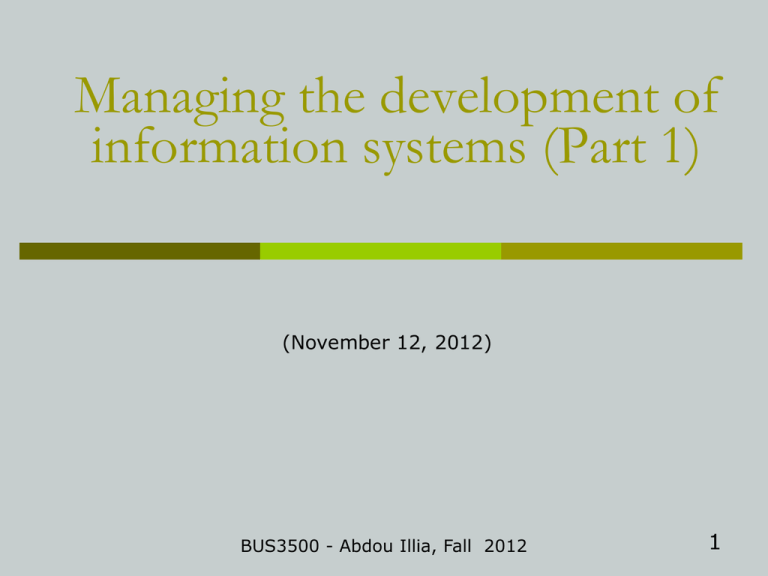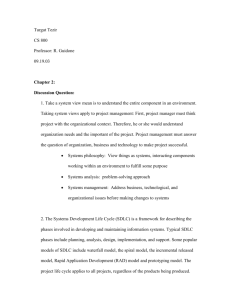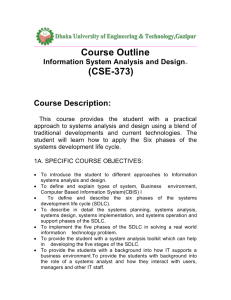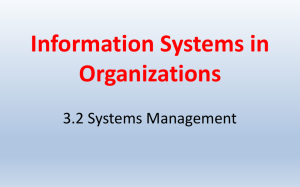INTRODUCTION TO INFORMATION SYSTEMS TECHNOLOGY
advertisement

Managing the development of information systems (Part 1) (November 12, 2012) BUS3500 - Abdou Illia, Fall 2012 1 LEARNING GOALS Explain the purpose of systems development methodologies - SDM. Describe the major phases of the traditional Systems Development Life Cycle (SDLC) methodology. 2 Systems Development Methodology? The process companies go through to develop and maintain an information system Framework for successful IS development A System Development Methodology is used For building a new system Or for modifying an existing system Examples of SDM: System Development Life Cycle ■ Prototyping Joint Application Development ■ Rapid Application Development 3 Questions Which of the following is true about SDM? a) They provide guidelines for developing IS and maintaining them which includes upgrading and improving them. b) SDM are needed when a brand new IS has to be developed, but you don’t need to use a SDM when it comes to modifying an existing IS. c) When a company is engaged in developing an IS, the process involves the company’s employees who would be the potential users of the IS, and IS professionals like system analysts and programmers. But it doesn’t involve the company’s management d) All of the above 4 Traditional Systems Development Planning Life Cycle (SDLC) Analysis Seven phases 1) 2) 3) 4) Planning Systems Analysis Systems Design Development Design 5) Testing 6) Implementation 7) Maintenance Development Testing Implementation Typically one phase needs to be completed before beginning the next Problem in later phase may require return to previous phase Maintenance 5 Question In SDLC, the 7 phases are typically followed in a sequential order, which means we don’t return to a previous phase in any circumstances True False 6 Planning Technical Analysis Do the technologies exist to develop the system? Economic Analysis Can the organization afford the system? Will it provide an adequate Benefit? Operational Analysis (i.e. assessing the human factors that could make the project fail) Resistance to change Organizational politics System development schedule System Development Schedule Feasibility analyses Feasibility Analyses Is the proposed development time line realistic? Is the programming team available during Programming step? Planning performed by Project Manager using Search and investigation (e.g. for technical analysis step) Total Cost of Ownership analysis 7 Project Management software Systems Analysis Analyze current system Define new system requirements Systems analyst works with company to fully understand the problem, and to detail the requirements of the proposed system Step 1: Analyze current system Objectives: Understand what things are done and how (business processes) Identify any problems associated w/ current business processes Techniques used: Observing employees at work Talking to/interviewing employees (potential users) Conducting interviews 8 Systems Analysis Analyze current system Define new system requirements Step 2: Define new system’s requirements Main Objective: To be defined: Specify What need to be done (not how to do it) Input requirements (nature of data, source, etc.) Processing requirements Output requirements (Types of reports, content, etc.) Storage requirements Tools and techniques used: Data flow diagrams (DFD) Start with high level process Add more levels with increased levels of detail Computer-Aided Software Engineering (CASE) tools Software that eases the systems development process 9 Questions During what SDLC phase software programs like Microsoft Project could be used? a) b) c) d) e) f) Maintenance Implementation Development System Analysis Planning None of the above Which of the following tools or techniques could be used during the System Analysis phase of the SDLC? (Choose all correct answers) a) b) c) d) e) Interviews Observing future users doing their job Using pseudocode Using software programs to draw data flow diagrams All of the above 10 Questions What kind of feasibility analysis seeks to determine if an organization can afford the new information system and if the system will provide the adequate benefits? a) b) c) d) e) Operational Feasibility Financial Feasibility Economic Feasibility Beneficial Feasibility None of the above During the Development phase of a new medical IS, the development team finds out that most of the technologies needed to develop and implement the system are not yet available on the market. At what step of the SDLC that kind of problem should have been identified? a) b) c) d) e) f) Maintenance Implementation Development System Analysis Planning None of the above 11 Data Flow Diagrams (DFD) Process . Symbolized by a rectangle or a curved rectangle. . Action performed by people of organizational units in order to transform input into output OR Action performed by people in the organizational units to help the units achieve their objectives Data flow . Symbolized by an arrow. . Shows data being passed from or to a process External Entity Symbolized by a square, an external entity is something (person, group, department, etc.) outside the system that interacts with the system by providing input or receiving information. Data storage Used to store data in the system. Represents a file, a database, etc. 12 Exercise 1: DFD Use Data Flow Diagram to illustrate your school’s registration system. Assume that Students are external entities. Also assume that there are three processes involved in course registration are: Verify Course availability after receiving a course request from a student. This involves checking the Course file Enroll the student in the course after verifying course availability. This involves updating the Student file. Confirm registration. This involves writing an confirmation letter and sending it to the student 13 Exercise 2: DFD Do the Lincoln Pizza’s ordering system DFD exercise available at: http://www.eiu.edu/~a_illia/BUS3500/DFDExercise.htm 14 Systems Design Physical system design Using the requirements from the Systems Analysis phase to design the new or modified system. Logical systems design Details the system’s functionality (what it should do?) Uses Structure charts to create top-down representation of system’s modules Uses System flowcharts to show relationships between modules Physical systems design Specifies all of the actual components (hardware, network, databases) used to implement the logical design The design must be frozen at end of this phase to prevent the to system grow indefinitely in terms of its scope and features Logical system design Scope creep Feature creep Performed by system designer or (system analyst15 in some case) Systems Design tools Order Entry SALES DATA Structure charts Process Pizza Order Payment Processing WEEKLY SALES REPORT System Flowchart: Graphical representation of all programs within the system and how they interrelate PAYROLL PROGRAM PAYCHECKS Delivery Module 1 WEEKLY SALES PROGRAM PAYROLL SUMMARY REPORT Inventory Management PAYROLL EXCEPTION REPORT Module 2 16 Creating databases Development Writing programs Implementing networks components Programming is usually the most difficult and time consuming in the Development phase. Development performed by programmers, database developers, and network engineers Programmers use Program Development Cycle 1) 2) 3) 4) 5) Review the input, processing, output, and storage requirements Develop the logic of the programs (using Flowcharts and Pseudo code) Write the programs using code generators & programming languages Test and debug the programs Complete the programs documentation 17 Development tools Program Flowchart: Graphical illustration of the problem-solving logic within a program Pseudocode: English-language statements that describe the processing steps of a program in paragraph form. Code generators: Software that generate programs that programmers could modify. Programming languages: -Java -C++ -Visual Basic -Etc. 18 Questions During what phase of the SDLC the Database component of a new system is created? a) b) c) d) e) f) Maintenance Implementation Development System Analysis Planning None of the above During what phase of the SDLC code generators could be used? a) b) c) d) e) f) Maintenance Implementation Development System Analysis Planning None of the above 19 Testing Programmers test modules Development team do unit testing Do they return proper outputs? Do they handle incorrect data appropriately? i.e. testing how modules work together System testing (software along with database and network component) Verification: Testing system in simulated environment with simulated data Validation: Testing system in real working environment with real data 20 Implementation Implementation strategies Direct cutover: Quick change to new system Parallel conversion: Old and new systems used in parallel for a while. Pilot testing: New system installed at only one location or one department Staged conversion: Only one part of the system installed, then another part is installed. User training 21 Maintenance Maintenance counts for as much as 80% of the total cost of an information system Tasks Correcting errors found during implementation System enhancements Incremental upgrades Addition of major new features 22 Questions The implementation strategy in which the old system is immediately replaced by the new one is called: a) b) c) d) Staged conversion Direct cutover Systematic testing None of the above Validation testing performed during the Testing phase of the SDLC ensures that the system is working properly in the real working environment using real data. a) True b) False 23 Problems with Traditional SDLC SDLC is time consuming SDLC is costly SDLC is rather inflexible SDLC gets users’ inputs ONLY during systems analysis and implementation phases 24 Summary Questions Book Notes 1) What is a System Development Methodology? What is it used for? 2) What are the 7 phases of the SDLC methodology? 3) What kind of Feasibility analyses need to be performed during the Planning phase? Why is the system development schedule important? 4) What are the two steps in the Systems Analysis phase? What techniques and tools are used during the Systems Analysis phase? 5) What tools do programmers usually use during the Development phase? 6) What is the difference between the Verification and the Validation tests performed during systems testing? 25







